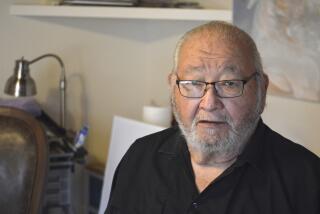Successful Artist, Architect Turns His Dyslexia Into a Wellspring of Creativity
- Share via
CIMARRON, N.M. — Morning sun brushes gold across the mind-stretching prairie to the east, infusing every blade of gramma grass with light. But night falls early, the sun pinched off by the jagged, deep navy edge of the Sangre de Cristos.
Here’s where prairie meets the mountains, and Bennett Strahan paints the vermilion horizon backward on glass, the first step in a one-of-a-kind printmaking process.
Strahan doesn’t just paint it backward--he sees it backward.
The 53-year-old artist, a Taliesin-trained architect whose career gained impetus from Frank Lloyd Wright himself, has the gift of dyslexia.
As a boy, Strahan read by holding books up to mirrors. He was treated as borderline retarded--until art took hold, with help from his great-great-uncle and encouragement from Wright. Now Strahan says dyslexia was about the best thing that ever happened to him.
“I think it has probably helped me more than any single thing I can think of,” he says. “Three-dimensional thinking was what was created by the dyslexia problem. I could design these things in my head.”
Frank Lloyd Wright’s Taliesin West at Scottsdale, Ariz., helped supply the discipline, structure and theory Strahan needed. He studied there from 1964-66.
And from this northeastern New Mexico town of 900, a onetime Wild West wagon and stagecoach stop, Strahan runs a multimillion-dollar architecture practice and an art gallery, the Buffalo Nickel. He paints, cans and sells pickles--and drives a 1924 Packard.
Strahan is currently working on four building projects totaling some $70 million--a $25-million resort, Tauqueta Falls in northern Georgia just south of Chattanooga, Tenn.; Walnut Cove, an even larger project near Asheville, N.C.; a $12-million solar-homes development, Galena Heights, near Lake Tahoe; and the $3-million Summersby Park at Hendersonville, N.C.
He helped restore Wright’s Auldbrass Plantation in Yemassee, S.C., now owned by filmmaker Joel Silver, producer of the “Die Hard” and “Lethal Weapon” movies. Silver, passionate about preserving Wright’s work, also owns Wright’s Storer House in Los Angeles.
“I’ve chosen the genre of commercial movies because I need hits to pay for the restoration of these houses,” Silver told the Architectural History Foundation in 1993.
Wright’s grandson, Eric Lloyd Wright of Malibu, commissioned Strahan for Auldbrass, a compound designed in 1939 by his grandfather on an antebellum plantation.
Silver hired him as project architect “and it went very well,” Wright recalls. “We worked several years together. He’s very capable in construction and has a good design sense.”
Strahan credits computer advancement for helping run his office in Cimarron, a modest corner of cattle country near the 138,000-acre Philmont Boy Scout Ranch. He’d passed through Philmont as a boy, and it drew him back as an adult.
“This is as majestic as anyplace I’ve ever been. You have that prairie coming in and slamming up against those mountains. No transition--just prairie and mountains,” he says. “I’m here because of the prairie, because of what I paint.”
In September, he sold 25 artworks, including 19 prairie monotypes, in Topeka, Kan.
“I’ve always felt my art had a market in the prairie states,” Strahan says. “These people love the prairie with a passion.”
With monotype, the reverse image is painted on glass, then the pane is pressed into soft paper for the positive image. Color separations require multiple impressions.
“The monotype process is real dyslexia-friendly,” he says. “To lay the color separations down on paper, you’ve got to do them backwards.”
Linda Silverman, a Denver child development therapist, has used Strahan as an example in counseling dyslexic youngsters--children with trouble decoding written words, who reverse letters and numbers. The right sides of their brains are stronger than the left.
Most schools focus on the left-brained, “academically talented child--great with reading, writing, calculations,” Silverman says. “All the things [such schools] focus on are to the detriment of kids who learn like Bennett. They take a lot longer to translate their images into words or numbers.”
Right-brainers often become scientists, musicians, math whizzes or artists, she says.
“The ones who have changed history, the Einsteins, Edisons, Faradays, any of the brilliant physicists, are right-hemisphere-gifted people,” she says. “They have more in common with the artists than they do with the English teacher.”
If not for his great-great-uncle, Charles Baker, whom he calls simply “Uncle,” Strahan, who grew up in Michigan, might never have overcome the prejudice that in the 1950s held back many dyslexics.
“Uncle told me, ‘Ain’t nothing wrong with you that can’t be fixed. You just need some rewiring,’ ” he says.
Strahan’s uncle taught him to visualize the back side of letters and words so he could read, and took him to meet Frank Lloyd Wright in Lansing, Mich.
“I was 11 or 12. There was a line of people waiting to talk to Mr. Wright afterward. We waited until everybody left. Mr. Wright said, ‘What can I do to help you?’
“I said, ‘I want to go to your school.’
“He said, ‘Don’t you think you’re a little young?’ ”
But Wright gave Strahan an application and initialed it. When Strahan submitted it to Taliesin West in 1963, the school sent it back with a note that he should frame it for historic value. They gave him a new application--and accepted him straight out of high school.
More to Read
The biggest entertainment stories
Get our big stories about Hollywood, film, television, music, arts, culture and more right in your inbox as soon as they publish.
You may occasionally receive promotional content from the Los Angeles Times.










